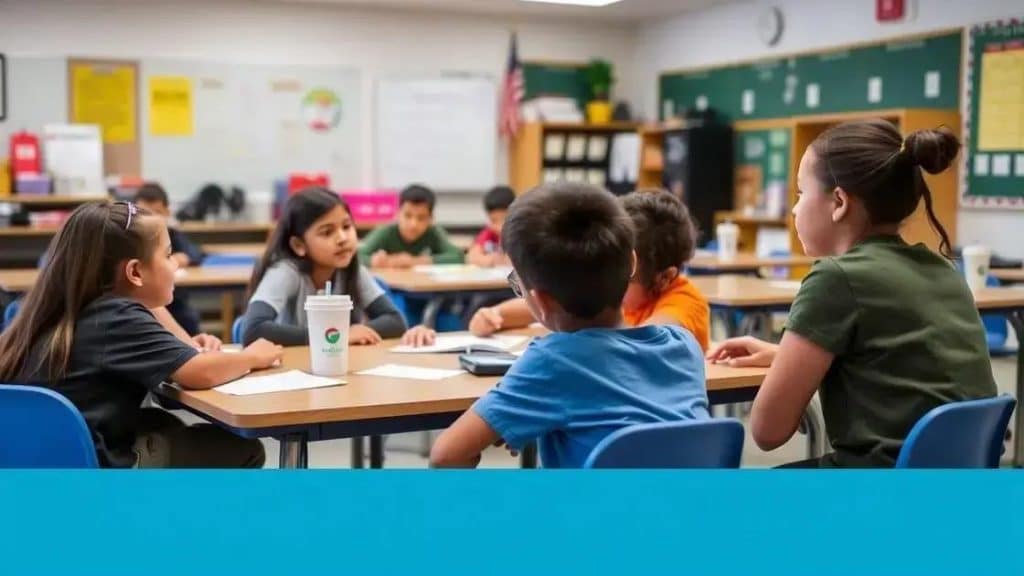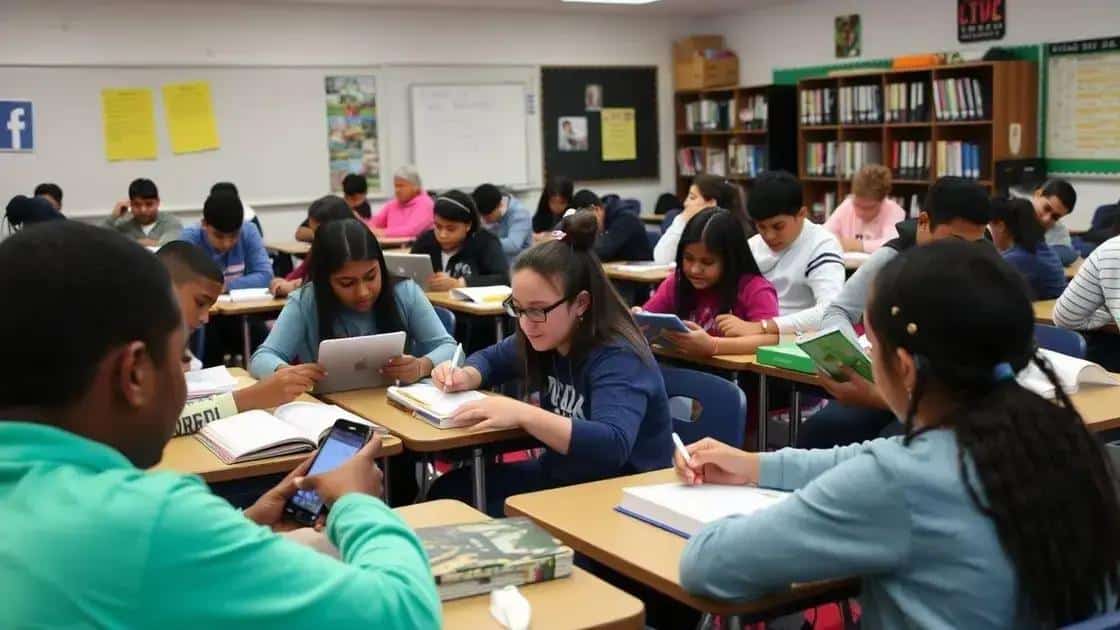Half textbook policy updates: what you need to know

The half textbook policy integrates traditional and digital resources, enhancing personalized learning experiences while preparing students for a technology-driven future.
Half textbook policy updates are transforming the educational landscape, leaving many wondering how these changes affect their daily learning and teaching experiences. Curious about what this means for you? Let’s dive into the details.
Understanding the half textbook policy
Understanding the half textbook policy is crucial for students, educators, and parents alike. This policy introduces a shift in how educational materials are utilized, aiming to enhance learning while reducing costs.
The policy promotes a blend of traditional textbooks and digital resources. This dual approach allows for greater flexibility in learning methods. As students engage with both print and electronic materials, they can choose the format that works best for them.
Key Components of the Half Textbook Policy
Several vital aspects define this policy:
- Balancing print and digital resources
- Encouraging interactive learning experiences
- Reducing environmental impacts through less paper use
- Allowing for personalized learning paths
By focusing on these elements, the half textbook policy fosters a more engaging educational experience. Educators can tailor their teaching methods, accommodating diverse learning styles effectively.
Implications for Students and Educators
Students benefit from this policy by gaining access to a variety of materials. They can explore concepts through videos, interactive modules, and downloadable content. Such options can enhance their understanding and retention of knowledge.
Educators, on the other hand, can adapt their lessons based on real-time feedback from digital platforms. This adaptability means that they can address different learning needs more efficiently, ensuring every student has the opportunity to succeed.
In summary, the half textbook policy offers a comprehensive, modern solution for today’s learning environments. By merging traditional and digital approaches, it prepares students for the future while making education more effective and accessible.
Key updates in the latest policy
The latest updates to the half textbook policy bring significant changes that impact both students and educators. These adjustments aim to create a more effective and flexible learning environment.
One major update includes the integration of enhanced digital tools. Schools are increasingly adopting resources such as interactive e-books and online platforms. These tools not only encourage engagement but also allow for instant access to a wide range of materials.
Expanded Access to Resources
With the new policy, students are provided with a broader selection of learning materials. Here are key elements:
- Access to a larger library of digital content
- Incorporation of multimedia resources like videos and podcasts
- Increased availability of supplemental materials for different subjects
These resources help cater to diverse learning styles, ensuring that each student can find what they need to succeed.
Flexibility in Learning
The updated policy emphasizes the importance of learner flexibility. Students can choose how they want to engage with their studies, whether through traditional textbooks, digital formats, or a combination of both. This choice enhances motivation and personal investment in the learning process.
Teachers can also adapt their methods more easily, using both types of materials in their lessons. This ability leads to richer discussions and more interactive classroom experiences. As educators embrace new technology, they can enhance their teaching effectiveness and foster better student outcomes.
In conclusion, the key updates in the half textbook policy focus on providing diverse resources and fostering flexibility in learning. By implementing these changes, schools are better equipped to meet the needs of all students.
Impacts on student learning experiences

The half textbook policy significantly impacts student learning experiences by reshaping how educational materials are accessed and utilized. With this policy, students have more choices than ever before regarding their learning tools.
One of the primary effects of this policy is improved engagement. Students are now able to use a mix of digital and traditional resources, which caters to different learning styles. For instance, visual learners benefit from interactive apps, while others may prefer the tactile experience of holding a textbook.
Enhanced Learning Opportunities
This policy fosters enhanced learning opportunities by encouraging collaboration and resource sharing. Educators can facilitate group projects where students can access different types of materials, broadening their perspectives. Here are some key impacts:
- Increased motivation through interactive content
- Better access to diverse resources
- Opportunities for personalized learning paths
Such factors lead to higher student involvement and a more customized approach to education.
Development of Critical Skills
The half textbook policy also plays a critical role in developing essential skills in students. As they navigate both print and digital formats, they learn how to research, evaluate resources, and effectively manage their learning. These skills are vital in today’s technology-driven world.
Furthermore, by incorporating technology into their learning, students gain familiarity with tools that they will likely encounter in higher education and in their future careers. This experience prepares them for real-world applications and enhances their adaptability.
By offering varied resources and fostering skill development, the half textbook policy profoundly affects the way students learn and engage with their education.
Challenges educators face with new updates
Educators are navigating several challenges with the implementation of the half textbook policy. These updates bring opportunities but also present hurdles that require adaptation and support.
One major challenge educators face is the integration of new technology into their teaching practices. Not all teachers are familiar with digital tools, which can create a learning curve. This factor can lead to frustration if proper training is not provided.
Managing Diverse Learning Needs
Another significant challenge is managing the diverse learning needs of students. With multiple resources available, teachers must find ways to effectively incorporate both digital and traditional materials into their lessons. This task can be overwhelming without clear guidelines. Key challenges include:
- Ensuring all students have equal access to technology
- Differentiating instruction to cater to varied learning styles
- Evaluating student progress effectively across different platforms
These factors require educators to be flexible and creative in their approaches.
Balancing Workload and Planning
The workload for teachers has also increased with the incorporation of the half textbook policy. There’s a need for careful planning to integrate new materials while also covering the curriculum. Many educators feel overwhelmed because they must stay current with the latest educational technologies, content, and methodologies.
Furthermore, collaboration among educators becomes crucial. Sharing resources and strategies can help alleviate some of the pressures teachers face. Professional development opportunities should be available to support them in adapting to these changes effectively, ensuring they can provide a quality education.
As educators continue to work through these challenges, ongoing support and resources will be essential for a smooth transition to the new policy.
Future implications for educational systems
The half textbook policy carries significant implications for the future of educational systems. As schools adopt this approach, the landscape of learning is evolving, which can lead to various outcomes for both students and educators.
One important implication is the potential for more personalized learning experiences. With access to a mix of traditional textbooks and digital resources, students can tailor their education to their individual needs. This flexibility can lead to higher engagement and motivation, encouraging students to take an active role in their learning journey.
Transforming Teaching Methods
The introduction of this policy prompts a shift in teaching methods. Educators are encouraged to adopt new strategies and technologies in the classroom. This includes:
- Utilizing blended learning models
- Incorporating adaptive learning technologies
- Fostering collaborative projects that leverage various resources
Such changes can create dynamic classroom environments where students learn actively and collaboratively, enhancing their educational experience.
Preparing for Technological Advancements
As educational systems implement the half textbook policy, there is an increased focus on preparing students for a technology-driven world. Familiarity with digital tools will equip them with essential skills for future jobs. Schools must prioritize:
- Integrating technology into daily learning
- Teaching digital literacy and critical thinking
- Encouraging innovation and creativity among students
These skills will be crucial as the job market evolves, and students will be better prepared for the demands of the future.
Overall, the future implications of the half textbook policy look promising. By adapting to new educational approaches, systems can ensure that students receive a comprehensive and relevant education that meets the challenges of tomorrow.
FAQ – Frequently Asked Questions about the Half Textbook Policy
What is the half textbook policy?
The half textbook policy combines traditional textbooks with digital resources to enhance student learning experiences.
How does this policy personalize learning?
Students can choose from a variety of resources that match their individual learning styles, improving engagement and motivation.
What challenges do educators face with this policy?
Educators may struggle with integrating new technology and managing diverse learning needs in the classroom.
What are the future implications of this policy?
The policy promotes personalized learning and prepares students for a technology-driven job market, enhancing overall education quality.





